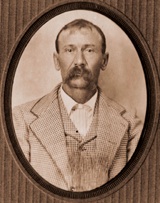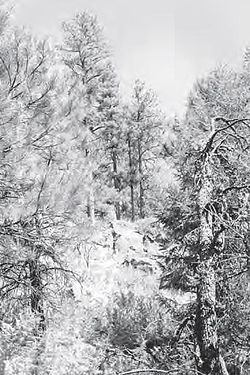
John Horton Slaughter, also known as Texas John Slaughter, was an American lawman, cowboy, poker player and rancher in the Southwestern United States during the late 19th and early 20th centuries. After serving in the Confederate States Army during the American Civil War, Slaughter earned a reputation fighting hostile Indians and Mexican and American outlaws in the Arizona and New Mexico territories. In the latter half of his life, he lived at the San Bernardino Ranch, which is today a well-preserved National Historic Landmark in Cochise County in far southeastern Arizona. In 1964, he was inducted into the Hall of Great Westerners of the National Cowboy & Western Heritage Museum.

John Peters Ringo was an American Old West outlaw loosely associated with the Cochise County Cowboys in frontier boomtown Tombstone, Arizona Territory. He took part in the Mason County War in Texas during which he committed his first murder. He was arrested and charged with murder. He was affiliated with Cochise County Sheriff Johnny Behan, Ike Clanton, and Frank Stilwell during 1881–1882. He got into a confrontation in Tombstone with Doc Holliday and was suspected by Wyatt Earp of having taken part in the attempted murder of Virgil Earp and the ambush and death of Morgan Earp. Ringo was found dead with a bullet wound to his temple which was ruled a suicide. Modern writers have advanced various theories attributing his death to Wyatt Earp, Doc Holliday, Frank Leslie or Michael O'Rourke.

William Brocius, better known as Curly Bill Brocius, was an American gunslinger, rustler and an outlaw Cowboy in the Cochise County area of the Arizona Territory during the late 1870s and early 1880s. His name is likely an alias or nickname, and some evidence links him to another outlaw named William "Curly Bill" Bresnaham, who was convicted of an 1878 attempted robbery and murder in El Paso, Texas.

The Earp Vendetta Ride was a deadly search by a federal posse led by Deputy U.S. Marshal Wyatt Earp for a loose confederation of outlaw "Cowboys" they believed had ambushed his brothers Virgil and Morgan Earp, maiming the former and killing the latter. The two Earp brothers had been attacked in retaliation for the deaths of three Cowboys in the Gunfight at the O.K. Corral on October 26, 1881. From March 20 to April 15, 1882, the federal posse searched southeast Cochise County, Arizona Territory for the men they believed were responsible for the attacks on Virgil and Morgan. Several suspects had been identified and were charged, but were soon released by the court, owing in some cases to legal technicalities and in others to the strength of alibis provided by the Cowboy gang. Wyatt subsequently pursued the suspects with a federal warrant.
Sherman McMaster (1853–1892) was an outlaw turned lawman, who was one of the six men involved in the Earp vendetta ride.

Commodore Perry Owens was an American lawman and gunfighter of the Old West. One of his many exploits was the Owens-Blevins Shootout in Arizona Territory during the Pleasant Valley War.
The Jesse Evans Gang, also known as The Boys, was a gang of rustlers and robbers led by outlaw and gunman Jesse Evans, which lasted from 1876 until 1880. The gang was formed after Evans broke with the John Kinney Gang. After breaking away, he brought along with him Billy Morton, Frank Baker, Tom Hill, Dolly Graham, George Davis, Jim McDaniels, Buffalo Bill Spawn, Bob Martin, Manuel "Indian" Segovia and Nicholas Provencio.

Mason Frakes Dalton, also known as William Marion "Bill" Dalton, was an outlaw in the American Old West. He was the co-leader of the Wild Bunch gang and with his brothers Gratton, Bob and Emmett Dalton was a member of the Dalton Gang.
Tom McCauley, better known by his alias James Henry or Jim Henry, was one of the many California Gold Rush criminals later a leader of the Mason Henry Gang.

The Cochise County Cowboys is the modern name for a loosely associated group of outlaws living in Pima and Cochise County, Arizona in the late 19th century. The term "cowboy", as opposed to "cowhand," had only begun to come into wider usage during the 1870s. In that place and time, "cowboy" was synonymous with "cattle rustler". Such thieves frequently rode across the border into Mexico and stole cattle from Mexican ranches that they then drove back across the border to sell in the United States. Some modern writers consider them to be an early form of organized crime in America.

Cochise County in southeastern Arizona was the scene of a number of violent conflicts in the 19th-century and early 20th-century American Old West, including between white settlers and Apache Indians, between opposing political and economic factions, and between outlaw gangs and local law enforcement. Cochise County was carved off in 1881 from the easternmost portion of Pima County during a formative period in the American Southwest. The era was characterized by rapidly growing boomtowns, the emergence of large-scale farming and ranching interests, lucrative mining operations, and the development of new technologies in railroading and telecommunications. Complicating the situation was staunch resistance to white settlement from local Native American groups, most notably during the Apache Wars, as well as Cochise County's location on the border with Mexico, which not only threatened international conflict but also presented opportunities for criminal smugglers and cattle rustlers.
Phineas Fay Clanton was the son of Newman Haynes Clanton and the brother of Billy and Ike Clanton. He was witness to and possibly played a part in a number of illegal activities during his life. He moved frequently in his early life from Missouri to California and to Arizona.
The Smith Gang was a band of American cattle rustlers who operated in the Southwest during the late 1890s to 1901. The gang was founded by Bill Smith and included six others, mainly Bill's family members. After an encounter with the law in Arizona Territory, known as the Battleground Gunfight, the Smith Gang was forced to escape to Mexico in October 1901.

The Apache Campaign of 1896 was the final United States Army operation against Apaches who were raiding and not living in a reservation. It began in April after Apache raiders killed three white American settlers in the Arizona Territory. The Apaches were pursued by the army, which caught up with them in the Four Corners region of Arizona, New Mexico, Sonora and Chihuahua. There were only two important encounters during the campaign and, because both of them occurred in the remote Four Corners region, it is unknown if they took place on American or Mexican soil.

The Skeleton Canyon shootout was a gunfight on August 12, 1896, between members of the High Five Gang and a posse of American lawmen. Following a failed robbery on August 1 of the bank in Nogales, Arizona, the High Fives headed east and split up. The gang's leader, Black Jack Christian, and George Musgrave got away.

Augustine Chacon, nicknamed El Peludo, was a Mexican outlaw and folk hero active in the Arizona Territory and along the U.S.–Mexico border at the end of the 19th century and the early 20th century. Although a self-proclaimed badman, he was well-liked by many settlers, who treated him as a Robin Hood-like character rather than a typical criminal. According to Old West historian Marshall Trimble, Chacon was "one of the last of the hard-riding desperados who rode the hoot-owl trail in Arizona around the turn of the century." He was considered extremely dangerous, having killed about thirty people before being captured by Burton C. Mossman and hanged in 1902.

Burton C. Mossman was an American lawman and cattleman in the final years of the Old West. He is most remembered for his capture of the notorious border bandit Augustine Chacon in 1902, though he was also a successful businessman who owned the large Diamond A Ranch in New Mexico.

The Gleeson gunfight, or the Gleeson shootout, was one of the last gunfights in the Old West, having occurred during the transition period between the "Old" and the "New." On March 5, 1917, the sheriff of Cochise County, Harry C. Wheeler, and his deputy, Lafe Gibson, were ambushed by a gang of Mexican alcohol smugglers near the town of Gleeson, Arizona. During the battle that followed, Wheeler and Gibson fought off the attackers and confiscated their alcohol, wounding at least one man in the process.

Bill Downing a.k.a. William F. Downing was a notorious outlaw during the Wild West era in Arizona. Downing had fled from the Texas Rangers posse who was after him when he came to Arizona. In Arizona, he was involved in the killing of William S. “Slim” Traynor and in various train robberies including the robbery of the Train Depot in the town of Cochise. Downing was so unpopular that even members of his gang couldn't stand him.
















